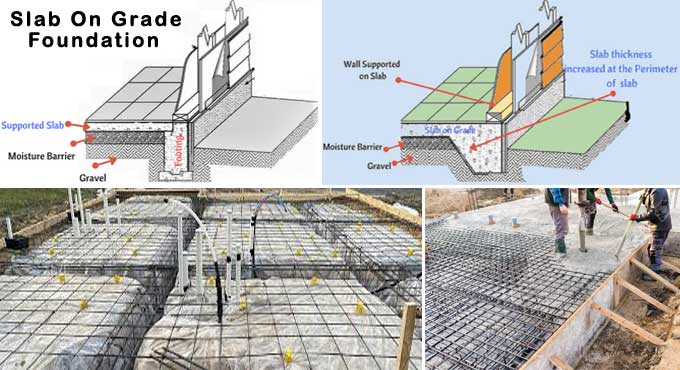NEWS | SOFTWARE | SHEET
How to Design a Concrete Slab on Grade
For the purpose of supporting structural elements and walls, the Slab on Grade is simply laid directly on the earth's surface. For slabs, the minimum thickness of the grade depends on soil characteristics and porosity, but generally 4 inches is the minimum thickness for slabs. Also known as floating slabs, slabs on grade are laid on the ground.
In areas where the ground doesn't freeze, slab on grade is popular. It depends on the local building codes and the floor loads whether or not reinforcement is inserted in these types of slabs. In order to prevent moisture from entering the concrete slab, a layer of bitumen and gravel is laid on the earth's surface prior to laying it.
This type of slab is prepared on the earth's surface as well. Structures and buildings are founded on slabs on grade & it does not require an additional type of footing.
A slab on grade supports the structural rudiments and walls on the ground's surface. Four elevation surfaces are evaluated based on the grade of the slab, which is the result of soil characteristics and porosity. A float slab is also referred to as a slab of quality.
In areas where the ground terminates fracture, slabs on grade are often used. In addition to the actual structure canons and bottom loads, these crossbeams may or may not utilize underpinning.
The earth's face is covered with a sub-case of Bitumen and clay before the concrete slab is applied to prevent the slab from becoming humid.
Concrete Slab on Grade Construction
The earth must first be excavated to the required depth and compacted to eliminate air voids before the grade can be laid on a slab. In order to identify the corners of the slab, batters are placed in positions as described in the plan before concrete is poured into it. This board can also be used to pour concrete into.
In order to build a slab, the soil is first investigated, and then the slab thickness is designed as per the investigation results. A layer of bitumen and gravel is poured into the surface of the soil.
Concrete slabs are protected by this gravel and bitumen layer to prevent groundwater from entering them. A thicker pour of concrete is used at the edges of the slab, thereby providing a footing for the slab, as well as reinforcement bars for strength.
During high temperature periods, control joints are placed between the slab and wall to minimize cracking. Expansion joints are also placed between slabs and walls for curing the stress action.
Grades on Slab Types
Supported Slab on Grade
The supported slab on grade is a slab that supports conventional footings. As well as acting as a moisture barrier, the slab is also supported by a grade and an expansion joint between the slab and wall is provided to relieve stress during periods of high temperature. A control joint was used on the support grade slab to prevent cracks on the surface and also raise the column.
Monolithic Slab on Grade
This concrete slab serves as the footing of the building, walls, and columns in monolithic slabs on grade. Batter boards are used to frame slab foundations with this type of grade. Because they act as a mould, batter boards are helpful in identifying slab corners.
Merits of Grade on Slab
It is sturdy, as the building or structure is directly supported by concrete and does not rely on supporting beams and supports. For garages, barns, and shed floors, slab on grade foundations are ideal. Excavation costs, labor costs, and forms are minimized on slab foundations.
There is no termite attack risk associated with the slab foundation for its high construction speed. It is more cost effective to build a slab of the grade under a structure than to build a crawl space or basement below it.
To get more details, go through the following video tutorial.
Lecturer: American Concrete Institute
Demerits of Grade in Slab
A slab foundation will likely settle down due to the grade. Extending a building creates a problem with the slab grade, as the lines are hard to check regularly.
Utility lines like gas lines, pipelines, and cable cannot be accessed on the slab's in-grade area. There is a high chance of flooding even in moderate rains due to the slab on the grade's low profile.


